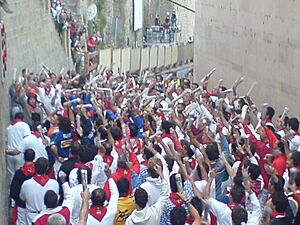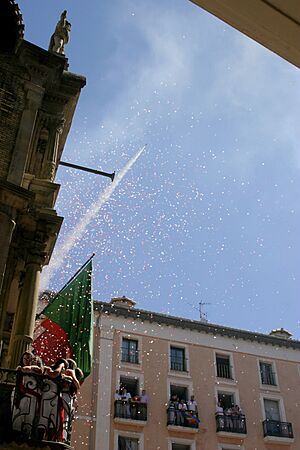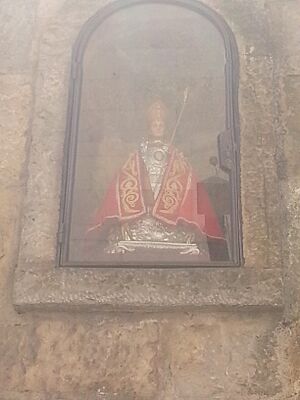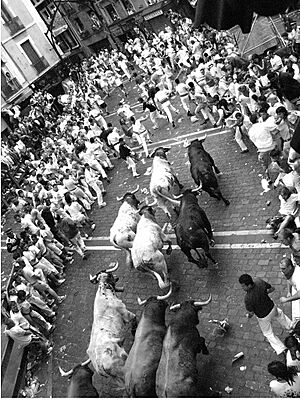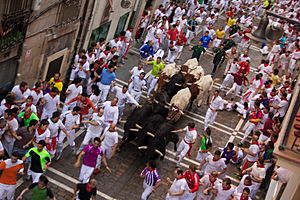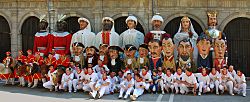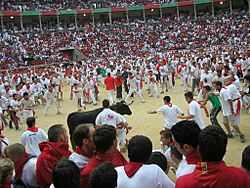Festival of San Fermín facts for kids
Quick facts for kids Festival of San Vermin |
|
|---|---|
| Nickname | Sanfermín, Sanfermines, Sanferminak |
| Begins | 7 July; 12:00 (CEST) |
| Ends | 15 July; 00:00 (CEST) |
| Frequency | Annual |
| Location(s) | Pamplona, Navarre, Spain |
| Activity | Running of the bulls |
| Patron(s) | Saint Fermin |
| Fiesta of International Tourist Interest | |
| Designated | 1980 |
The Festival of San Fermín is an old and famous celebration. It happens every year in the city of Pamplona, Navarre, Spain. The festival lasts for a week. It starts at noon on July 6 and finishes at midnight on July 14.
A special firework called the Chupinazo kicks off the fun. At the very end, people sing a popular song called Pobre de mí (which means 'Poor Me'). The most famous part of the festival is the running of the bulls. This exciting event happens every morning from July 7 to July 14. But there are many other traditional and folk events too! Locals call the festival Sanfermines in Spanish and Sanferminak in Basque. It honors Saint Fermin, who is a special patron saint of Navarre.
This festival became very famous around the world. This was especially true after the writer Ernest Hemingway wrote about it in his book The Sun Also Rises. Now, over a million people visit Pamplona to join in the celebrations.
Contents
Discover the History of San Fermín
Who Was Saint Fermín?
Fermín is believed to have lived in Pamplona a very long time ago, in the 3rd century. He became a Christian thanks to Saint Saturninus. Tradition says that Fermín was the first bishop of Pamplona. Later, he died for his beliefs and is now considered a martyr in the Catholic Church.
Saint Fermín and Saint Francis Xavier are the two patron saints of Navarre. Some stories say that Saint Fermín was dragged through the streets. This might be why the famous bull running tradition started.
How the Festival Began
The San Fermín festival started by combining two old events. First, there were summer fairs where people bought and sold cattle. Because cattle were in town, bullfighting became part of these fairs. Records show this happened as early as the 14th century.
Second, there were religious celebrations for Saint Fermín on October 10. But in 1591, these religious events were moved to July 7. This was done so they could happen at the same time as the fairs, when the weather in Pamplona is much nicer. This is considered the real start of the modern Sanfermines. In the past, the festival included music, plays, tournaments, and fireworks. Bull running became common in the 17th and 18th centuries. The famous Parade of Giants started in the mid-19th century.
San Fermín Today and in the Past

The festival became globally famous because of Ernest Hemingway. He was an American writer and journalist. He loved the festival after his first visit in 1923. He came back many times. Hemingway was very interested in bull running and bullfights. He wrote about them in his book The Sun Also Rises. Many places in Pamplona, like La Perla Hotel, are famous because Hemingway visited them.
The San Fermín festival has changed over time. In the past, young people saved money all year for the festivities. They wanted to enjoy the bull running, eat special foods, and have fun. The COVID-19 pandemic caused the festival to be canceled in 2020 and 2021.
Exciting Daily Events
The Chupinazo Opening
The festival officially begins with the chupinazo (or txupinazo in Basque language). This is a firework rocket launched at noon on July 6. It goes off from a balcony at the city hall. Thousands of people gather in the square to celebrate this moment. The chupinazo has started the fiesta every year since 1941. The city mayor usually decides who gets to light the rocket. Sometimes, special people who have done great things for the city get this honor. After the rocket, a band plays music, and the party truly begins!
The Saint Fermín Procession
July 7 is a very important day. Thousands of people join a procession through Pamplona's old town. They walk with a 15th-century statue of Saint Fermin. Dancers, street performers, and city leaders join in. During the procession, a traditional dance called a Jota is performed for the saint. The giant figures, called "gigantes", also dance and spin. A special bell named María rings from the cathedral.
The Struendo (The Roar)
"El Struendo" means "The Roar." This is a fun event that has been happening for over 50 years. It's not part of the official schedule. People gather at the City Hall at 11:59 PM. They make as much noise as possible for several hours! They use drums, cymbals, pots, whistles, and anything else that makes a sound.
The Pobre de Mí Closing
After nine days of celebration, the festival ends. People gather in the City Hall Plaza at midnight on July 14. They sing the sad song Pobre de Mí ('Poor Me'). Everyone holds a candle. The city mayor officially closes the festival. People take off their red handkerchiefs as the local band plays the song. This closing ceremony tradition started in the 1920s.
Daily Adventures at San Fermín
The Running of the Bulls
The running of the bulls is called encierro in Spanish. Hundreds of people run in front of six bulls and six steers. They run down an 825-meter (about half a mile) path through narrow streets. The run ends in Pamplona's bullring. It usually takes about 3 minutes. The bulls stay in the bullring until the bullfight later that afternoon.
The bull runs happen every day from July 7 to July 14. Each day features a different type of bull. The event starts at 8:00 AM. A first firecracker goes off to announce the bulls are released. Before the run, people gather to ask Saint Fermín for protection. They sing a chant three times in both Spanish and Basque:
“A San Fermín pedimos, por ser nuestro patrón, nos guíe en el encierro, dándonos su bendición.
Entzun, arren, San Fermin zu zaitugu patroi, zuzendu gure oinak entzierro hontan otoi.”
(Both mean: “To San Fermin we ask to be our patron saint and to guide us in the running of the bulls, giving to us his blessing”)
After the chant, people shout Viva San Fermin and Gora San Fermin! A second firecracker means all the bulls have left their pens. Six fighting bulls are guided by six oxen (often white and brown). Three more oxen follow them. Shepherds in green shirts also help guide the bulls with long poles.
When all the bulls are in the bullring, a third rocket goes off. A fourth firecracker means the run is over. After the main run, young cows with wrapped horns are released into the bullring. They playfully toss participants around, which the crowd enjoys.
The bull run is exciting but can be dangerous. Since 1925, 15 people have died during the event. Every year, between 200 and 300 people get hurt. Most injuries are minor bumps and bruises from falls. The event is broadcast live on TV in Spain and around the world.
Giants and Big-Heads Parade
Every morning, there is a fun parade of gigantes y cabezudos. These are "giants and big-heads." The giant figures are over 150 years old! There are eight giant figures. They were made in 1860 and represent kings and queens from different parts of the world: Europe, Asia, America, and Africa. Each giant is about 4 meters (13 feet) tall. A dancer carries them from inside a wooden frame. The giants dance to traditional music during the parade.
There are also 17 other figures. These include 6 kilikis, 5 big-heads, and 6 zaldikos. They were made between 1860 and 1941. Kilikis and big-heads are funny, human-like figures worn as helmets. Big-heads are up to 1 meter (3 feet) tall. Kilikis are a bit smaller. Big-heads walk in front of the giants and wave to people. Kilikis and zaldikos (horse figures) run after children and playfully tap them with a soft stick.
Traditional Sports
Every morning, you can watch exhibitions and competitions of Basque rural sports. These happen in the "Plaza de los Fueros." Sports include stone lifting, wood cutting, and hay bale lifting. There is also a special Jai alai tournament. Jai alai is a fast-paced game that is part of basque pelota. It's played in special courts in the city. People often place bets during these events.
Bullfight
Every afternoon from July 7 to 14, there is a bullfight. This is where the six bulls from that morning's bull run are featured. The bullfight starts at 6:00 PM. On some days, there are also bullfights with younger bulls or bullfighters on horses. Pamplona's bullring is one of the largest in the world. It is always full, and tickets are very hard to get!
Fireworks Display
Every night at 11:00 PM, there is a spectacular firework show. It takes place at the citadel park. Fireworks have been part of Sanfermin since 1595. From 2000 to 2019, and again since 2022, an international fireworks contest is held. Thousands of people gather on the grass around the citadel to watch the amazing display.
See also
 In Spanish: Sanfermines para niños
In Spanish: Sanfermines para niños
- Fiestas of International Tourist Interest of Spain


